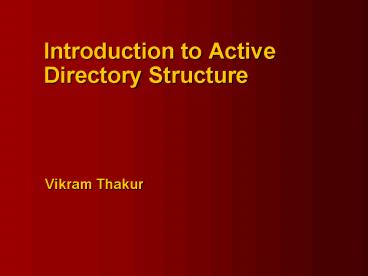Introduction to Active Directory Structure - PowerPoint PPT Presentation
1 / 30
Title:
Introduction to Active Directory Structure
Description:
They check for DB Consistency. They maintain the domain information. AD Properties ... User Principal Name 'bob_at_domain.com' Global. catalog. Forest Planning ... – PowerPoint PPT presentation
Number of Views:480
Avg rating:3.0/5.0
Title: Introduction to Active Directory Structure
1
Introduction to Active Directory Structure
Vikram Thakur
2
Agenda
- Introduction to Active Directory
- FSMO Roles
- Replication
- Active Directory deployment planning
- Guiding principles
- Structure planning
- More information
3
Introduction to Active Directory
- What is it?
- How does it help?
- How is it stored?
- Where is it stored?
- Can its scope be extended?
4
Domain Controller
- These are Logon or Authenticating servers
with the NTDS Directory - Under any circumstances there should be at least
2 of these DCs - They check for DB Consistency
- They maintain the domain information
5
AD Properties
- It doesnt require the PDC/BDC structure
anymore.that went away with NT4 - Delegation is possiblemore later
- It provides an LDAP interface to other
applications - Multiple Domains can be a part of a single AD
with Inter Site Trust (Forests)
6
Storage Structure of AD
- Comprises of 2 parts
- Transaction Logs
- Database
- SYSVOL (old NETLOGON)
7
FSMO
- FSMO Flexible Single Master of Operations
- Schema
- PDC
- RID
- Domain Naming
- Infrastructure
8
Global Catalogs (GCs)
- Hold limited form of AD
- Can be modified by using the SCHMGMT.DLL
- Used for location of resources
9
Replication
- AD works in Multi-Master mode by default
- Happens every 5 minutes
- Default Every DC replicates with 2 other DCs
- KCC is part of LSASS (Monitoring that will tell
you when you need another DC) - USN (Update Sequence Number)
10
Planning and Deployment
11
Deployment Planning
- Three steps
- Assess your environment
- Create Active Directory structure plan
- Create migration plan
12
Guiding Principles
- Keep it simple
- Aim for the ideal design
- Evaluate several alternatives
- Anticipate change
13
Structure Planning
Forest plan
Domain plan
- Deliverable planning documents
OU plan
14
Forest Planning
- Start with a forest plan
Forest plan
Domain plan
OU plan
Site topology
15
Forest PlanningConcepts
User Principal Name bob_at_domain.com
16
Forest PlanningMethodology
- Start with a single forest
- Create change control policy
- Schema Admins and Enterprise Admins group
membership - Multiple forests may be required
- Cannot agree on change control
- Division requires own schema or config
- Complete trust undesirable
17
Forest PlanningInter-forest Considerations
- Users must be aware of structure
- Explicit query to domain outside forest
- Import objects from other forests
- Config, schema managed separately
- One-way, non-transitive trust only
18
Forest PlanningExamples
- Central authority
- Single forest
- Conglomerate, autonomous division
- May require multiple forests
- ISP or hosting scenario
- Multiple forests
- No reason to share schema, config or to have
complete trust
19
Domain Planning
Forest plan
- Create a domain plan for each forest
Domain plan
OU plan
20
Domain PlanningConcepts
- A domain is a partition of a forest
- Unit of partitioning for replication
- Administrative and policy boundary
- Scope of authority of Domain Admins
- Policy and access control do not flow between
domains
21
Domain PlanningMethodology
Forest plan
Partition
Domain plan
Select Forest Root
OU plan
Create Hierarchy
DNS Support
22
Domain PlanningPartitioning
- Start with a single domain
- Justify each additional domain
- Example justification
- Administrative partitioning (admin/policy)
- Physical partitioning (replication)
- Upgrade existing domain in-place
23
Domain PlanningObsolete Reasons to Partition
- WinNT 4.0 40,000 object limit
- Active Directory tests 1,500,000
- Primary Domain Controller (PDC) availability
requirements - Active Directory is multi-master
- Delegation of administration
- Resource domains no longer needed
- Delegate within a domain using OUs
24
OU Planning
Forest plan
Domain plan
- Create an OU plan for each domain
OU plan
25
OU PlanningConcepts
- An Organizational Unit (OUs) is a container
inside a domain - Nested to create hierarchical structure
- Not a security principal
- Easily changed
- Typically not exposed to users
- Depth does not impact performance
26
OU PlanningMethodology
Forest plan
Domain plan
Delegate Administration
OU plan
Apply Group Policy
27
OU PlanningDelegate Administration
- Objects can be permission on a per-attribute
basis - Very flexible delegation possible
- Minimize number of Domain Admins
- Example procedure
- Delegate full control
- Delegate full control per-object class
- Delegate control of specific attribute
28
OU PlanningApply Group Policy
- Group policy is used to control desktop
configurations - Applied to Users and Computers
- Associated with Sites, Domains, or Organizational
Units - Create OUs to apply unique policy
- Filter application of policy using access control
29
Summary
- Deployment planning
- Assess current environment
- Structure planning
- Migration planning
- Start with structure planning
- Forest, domain, OU
- Guiding principles
- Keep it simple
- Anticipate change
30
For More Information
- Read the Windows 2003 Deployment Guide (on the
Windows 2003 CD) - Read the Distributed Systems book in the Windows
2003 Resource Kit - Watch for whitepapers on the Windows 2003 Server
home page - http//www.microsoft.com/windows/server/
31
Scenario Discussion time permitting































